

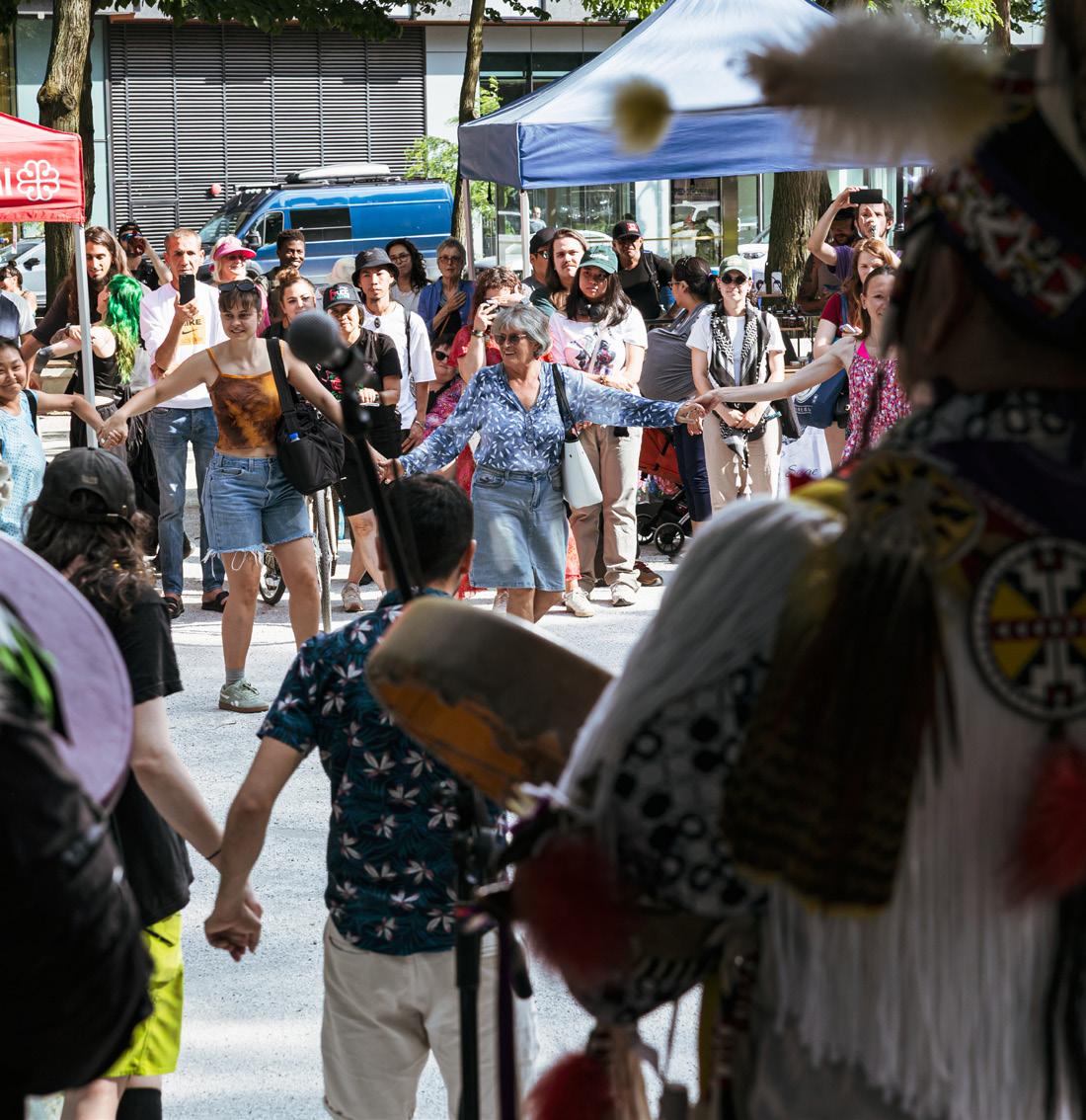

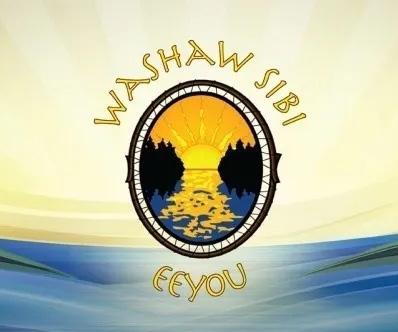

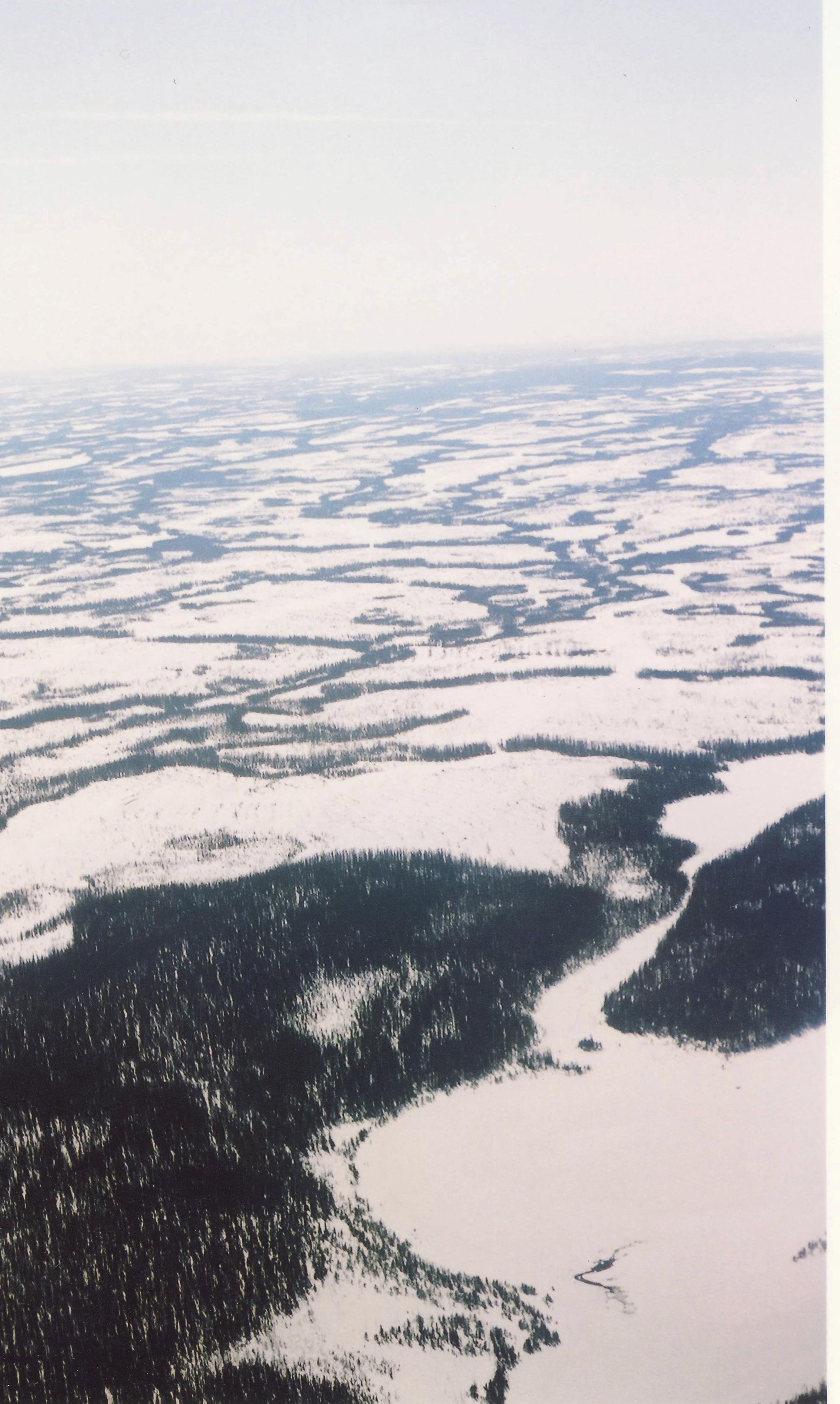






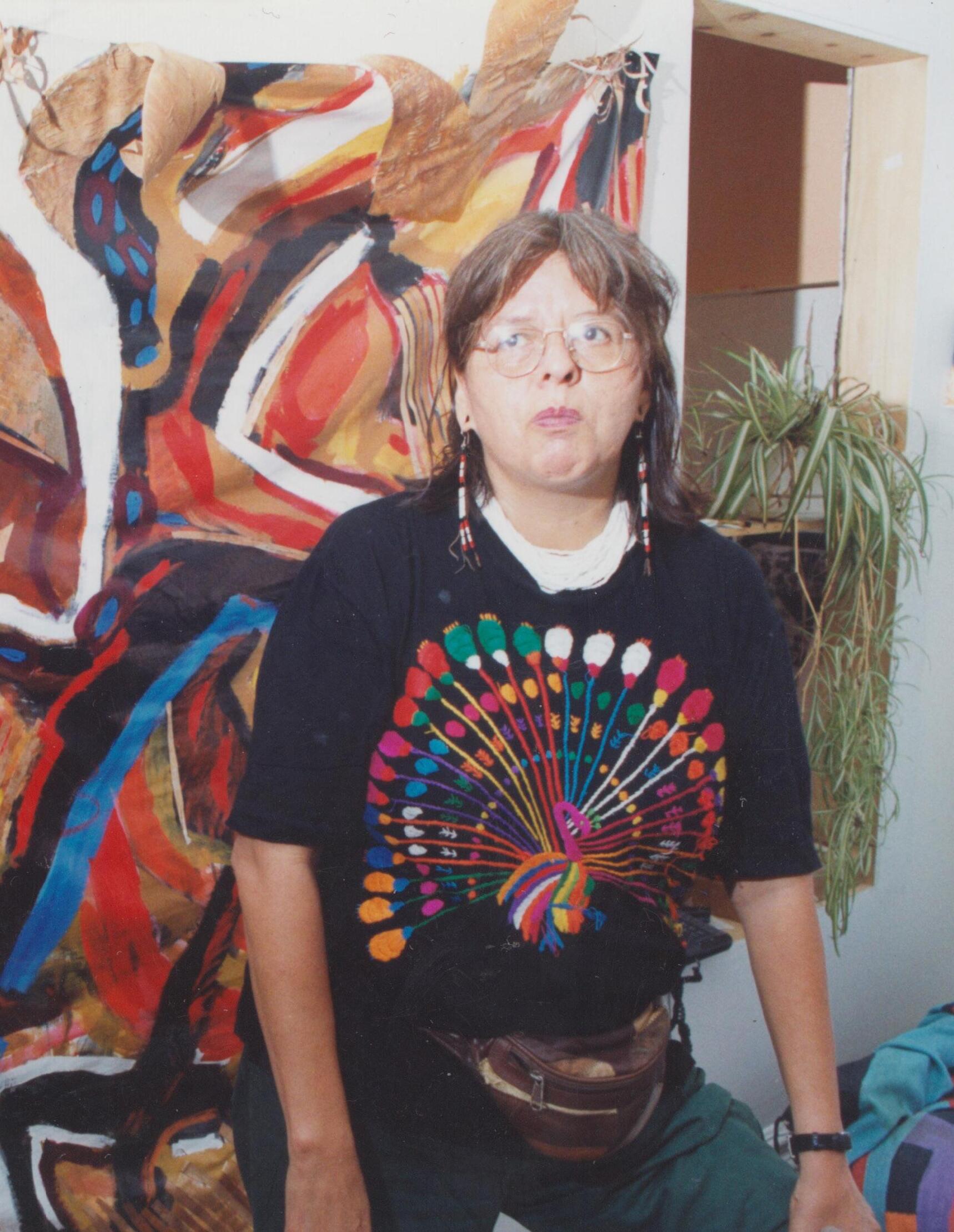
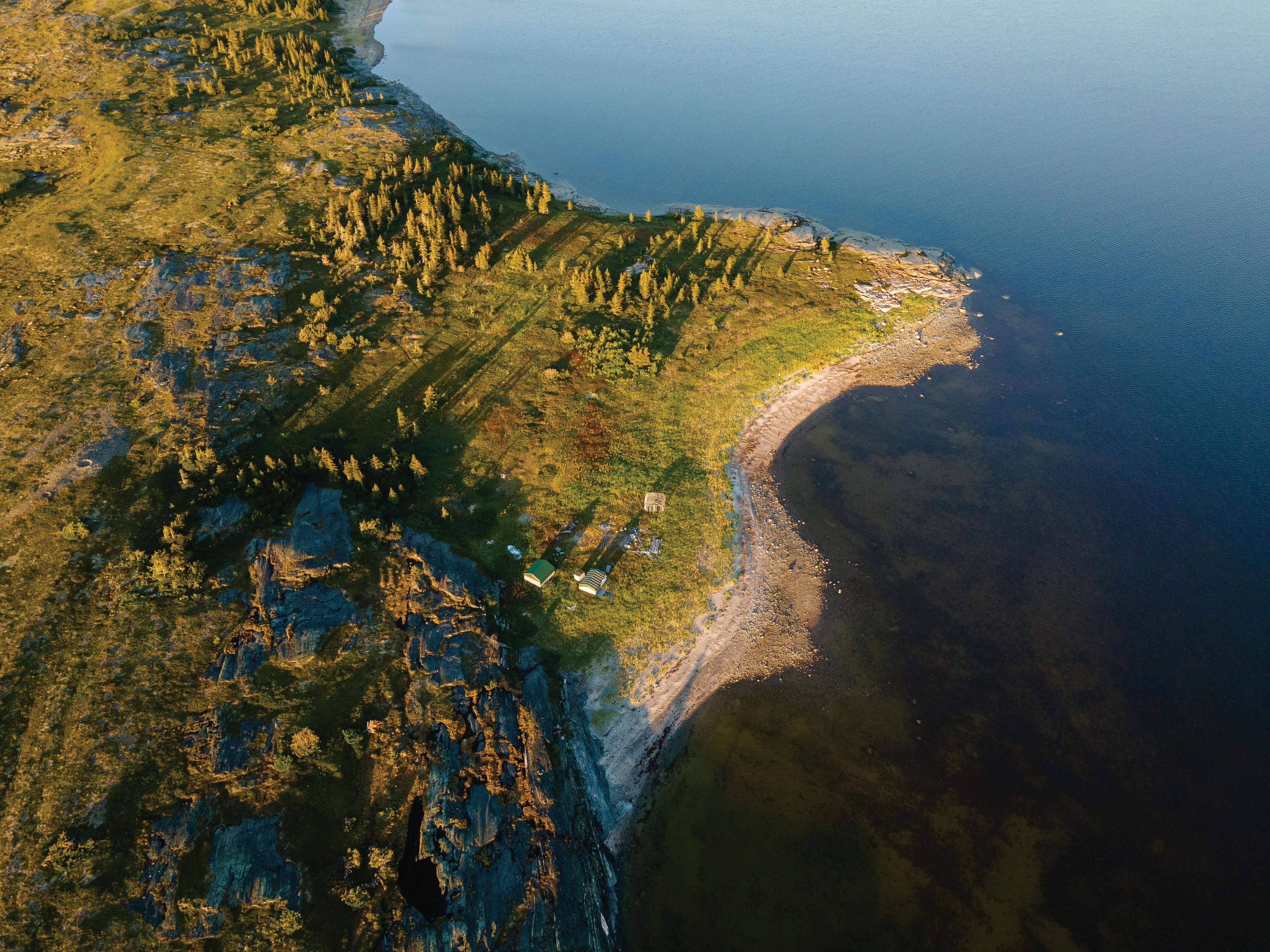




















by Patrick Quinn, Local Journalism Initiative Reporter
Resistance continues to mount against Quebec’s proposed forestry reforms in Bill 97. The latest in a series of demonstrations saw 100 protesters march from Montreal’s Olympic Stadium June 22.
Tabled in April by Natural Resources Minister Maïté Blanchette Vézina, the legislation would divide forests into three categories: conservation zones, multi-purpose zones balancing conservation and development, and intensive logging zones. By 2028, Vezina suggested, at least 30% of Quebec’s forests would be used exclusively by industry.
Members of the Innu, Atikamekw and Abenaki nations organized the MamoMamu alliance (meaning “together”). They raised teepees to mark Indigenous sovereignty on unceded lands and staged blockades to halt logging activities.
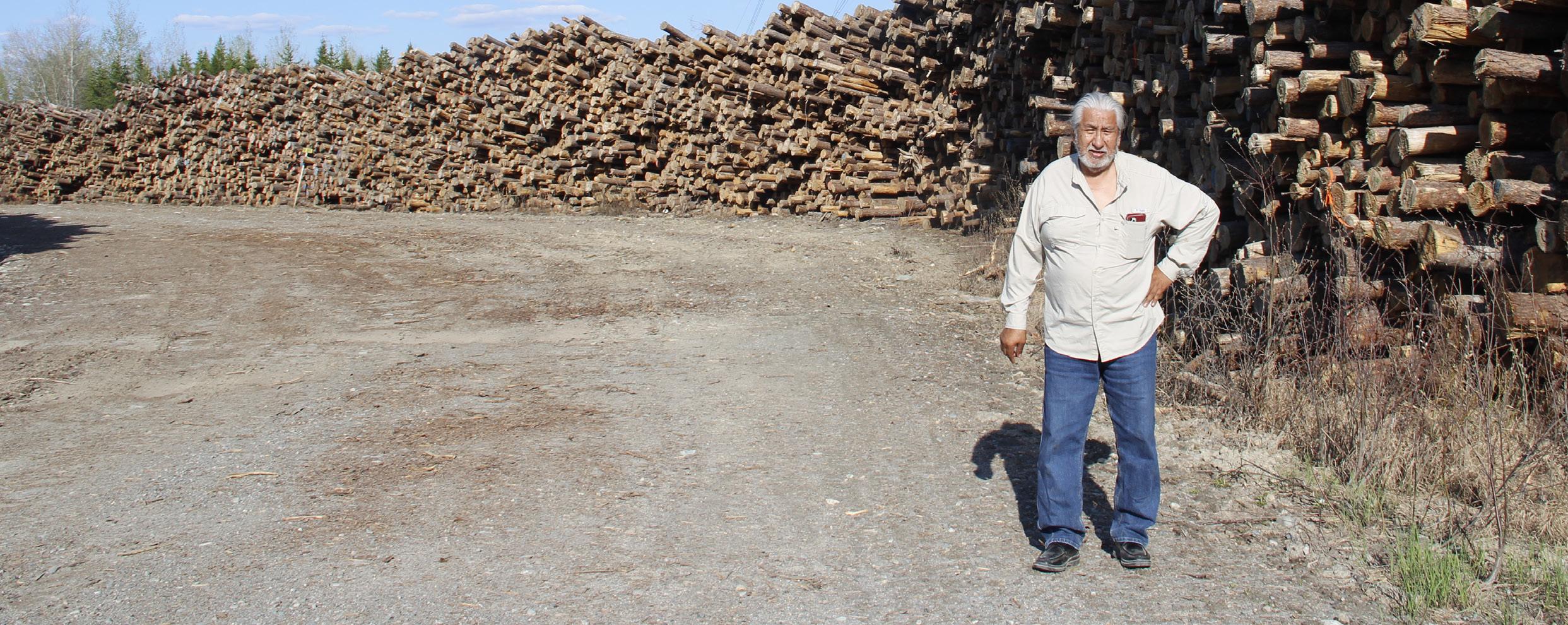
While forestry corporations support Bill 97, it’s opposed by Indigenous leaders, environmental groups, unions and forestry researchers. CSN-affiliated unions say giving industry the power to manage forestry zones would rapidly deplete the resource, threatening longterm employment.
Professor Christian Messier, an expert on forest ecology, proposed the approach that inspired the bill in order to prioritize biodiversity. But he said it should “not be implemented with the primary objective of helping the forestry industry.”
First Nations leaders rejected the bill before it was introduced. An open letter from 20 chiefs in December declared “you cannot partition the territory to dispossess us of part of our land and offer it to industry.”
“This bill needs to be completely reformed,” said Francis VerreaultPaul, Regional Chief of the Assembly of First Nations Quebec and Labrador. Disappointed that the AFNQL’s recommendations to the minister were ignored, he said the bill gives industry the right to bypass consultations with First Nations.
Bill 97 allows Indigenous activities in forestry zones, but the AFNQL said that clause “in no way guarantees the preservation of the quality of these territories.”
In May, Mamo-Mamu and the Association des Gardiens du territoire Nehirowisiw Aski (Abenaki) sent eviction notices to 11 forestry companies, ordering them to immediately remove their workers and equipment from unceded Indigenous territory. The letter targeted “multifunctional harvesters”, ordering companies to evacuate all employees and contractors.
The opposition prompted BlanchetteVézina to suggest “significant amendments will be made, particularly in collaboration with First Nations.” However, Premier François Legault later said that no major changes were planned.
On June 9, the Cree Nation Government announced a review of Bill 97 and meetings with Quebec to ensure the legislation respects “treaty obligations, shared commitments and recognized governance structures.” The CNG said the bill does not take legal precedence over forestry provisions in 2002’s Paix des Braves agreement.
“The Paix des Braves is a legally binding agreement, and the Adapted Forestry Regime is incorporated by reference to the JBNQA, which is constitutionally protected,” read the statement. “As such, it forms part of the Cree Nation’s treaty framework and reflects the mutual obligations of both the Cree Nation and the Government of Québec.”
Under the Adapted Forestry Regime, the Cree are collaborators in the industry’s management plans. Cree traplines remain the basis for forest planning, with tallymen able to designate Sites of Special Interest (1%) and Areas of Wildlife Interest (25%).
However, many Cree land defenders feel that protected areas are insufficient, and that existing agreements are not being respected. One complaint is that wildlife habitat directives that were to be included in the Paix des Braves have yet to be implemented.
In 2023, the CNG paused consultations with Quebec after the government blamed that summer’s forest fires for again failing to address the issue. While Schedule C-5 in the 2002 pact allows logging in 70% of a forest fire site, Crees say species like moose and bear feed from the resulting new vegetation.
“It’s impossible for them to cut so much,” said Waswanipi forest expert Allan Saganash. “They only cut the first year, then say the lumber’s no good because there’s too many insects eating the trees. Many traplines closed from the fires were reopened because they’re having requests for biomass.”
Biomass can be processed at nearby Chapais Énergie as renewable fuel or feedstock. Following fires, companies salvage remaining wood then mechanically scarify the land and eliminate competitive growth. Saganash explained that each stage damages the territory and is incompatible with the Cree way of life.
Cree tallymen increasingly reject forestry plans that ignore their wishes for trapline protection. Paul Dixon is currently in a conciliation process with the Cree-Quebec Forestry Board over his refusal to allow further logging activities on trapline W23A.
“I’m the first tallyman who said you can’t touch that burnt wood and requested they plant birch and poplar trees for mooseyards,” said Dixon. “They shouldn’t cut on hills and mountains, and should leave larger buffer zones of trees near shorelines.”




by Joshua Janke
It began with a court decision but quickly turned into a heated national controversy for North America’s oldest corporation.
In April 2025, the Hudson’s Bay Company received court approval to sell thousands of artifacts and art pieces it has collected since its incorporation in 1670.
Long held in storage or select exhibits, the collection includes more than 4,400 objects ranging from paintings to fur-tradeera friendship agreements, textiles and archival documents – many of which are believed to have cultural, ceremonial and political significance for Indigenous communities across the country.
The auction will be overseen by the Vancouver-based Heffel Gallery. Ontario Superior Court Justice Peter Osborne determined the sale could proceed if it struck a reasonable balance between the company’s debt restructuring process and the interests of its creditors and stakeholders.
Hudson’s Bay, which filed for protection under the Companies’ Creditors Arrangement Act, is dissolving remaining operations under financial strain. The sale of cultural assets is part of that exit strategy, but the court’s decision didn’t come without warning signs.
Justice Osborne heard from Asad Moten, a lawyer representing the Attorney General of Canada and other federal government bodies.
“Canada cautiously does not oppose” Hudson’s Bay’s move to auction off its artifacts, Moten said. “I say cautiously because Canada has not been afforded a chance to catalogue the artifacts.”
The court then ordered that a full inventory be shared with federal officials and representatives of the Assembly of Manitoba Chiefs (AMC). Still, the ruling set a dangerous precedent: allowing a private company to liquidate cultural and historical items before communities tied to them could identify, review or claim the items.
In a statement, the AMC, the Assembly of First Nations and Manitoba Keewatinowi Okimakanak (MKO) called for the immediate return of any sacred cultural artifacts in the collection.
“Our history is woven into the fabric of HBC’s beginnings, and reclaiming these artifacts is essential to honour and preserve the contributions and heritage of our ancestors,” said MKO Grand Chief Garrison Settee. “This is a matter of ethics. This is a matter of justice.”
Settee and others lobbying to stop the auction say there has been no meaningful communication with HBC, the courts or the federal government.
AMC Grand Chief Kyra Wilson said selling such items “without full transparency and consultation with impacted First Nations” would extend “the colonial dispossession of First Nations’ lands and belongings that the HBC directly profited from for centuries.”
“Reconciliation needs to come with action,” she added, calling for a First Nations-led process to determine their rightful ownership.
HBC’s origins are inseparable from colonization. Its earliest operations were built on Indigenous knowledge and trade networks, especially in Waskaganish, where the company first landed in 1668.
Charles Hester is Waskaganish’s Director of Culture, Sports and Leisure and an unofficial historian. He noted that the Cree not only welcomed the traders, but advised them where to settle.
“If it wasn’t for our people, I don’t think Hudson’s Bay would have been that successful. Our ancestors helped build Canada by helping Hudson’s Bay.”
The fur trade wasn’t imposed on the Cree, it was integrated into their economy, and Cree leaders became essential to its success.
“When they came in, it was our people that suggested they establish here on the river, because this was a trade route
that goes to all the Cree communities, all the way to Labrador. So, they just had to plug into that trade route – everything was already established.”
Hester says this legacy is part of why Cree people have long been successful in business. “We’ve been doing business with our European settlers for 350 years now. So, it’s not something that’s new to the Cree.”
Hester himself was part of that tradition. “When I was 11 or 12 years old, I went out with my grandparents and I spent the winter with them out on the trapline,” he recalled. “That year I managed to trap six martens. That was my first paycheque ever – it was from the Hudson’s Bay Company.”
But the centuries-long relationship brought change as well. Hester pointed out how the commercialization of traditional practices altered community values.
“Traditionally when you went out and got a moose, you shared your kill with the Elders or with the widows at no cost,” he said. “But now everything has a cost. There was a dollar value placed on everything, and I think that changed Cree society.”
That contrast between legacy and current practice is also felt by Indigenous business owners today.
Jason Thompson, owner of Superior Supplies Inc. in Thunder Bay, says he’s still waiting on an $80,000 payment from HBC for a contract completed nearly a year ago. His company, which supplies paper products, signed the deal in September 2023 and was told payment would come within 90 days. But as the deadline neared, communication from HBC dried up.
“As we were approaching the 90-day mark, that’s when the ghosting and the lack of communication really started,” said Thompson, who is from the Red Rock Indian Band.
Now, with HBC in insolvency, he fears the money will never come. “My ultimate worry is we’re never going to see a dime.”
The experience cuts deeper than a financial loss. It challenges the sincerity of corporate commitments to Indigenous economic reconciliation.
“The horrors and atrocities for us Indigenous people are well-documented,” Thompson said. “Yet this is how they’re going to proceed – without even entering into any dialogue.”
With thousands of items on the auction block and Indigenous businesses left in financial limbo, Thompson wonders: “What does reconciliation really mean if they won’t even pay their bills?”
At the heart of the backlash is the demand for transparency. While HBC argues it will eventually detail items for sale, critics say the very act of initiating an auction without consultation undermines reconciliation and the rights of Indigenous nations to their own heritage.
Governor General Mary Simon, whose family history is tied to the HBC through her father’s position as a former company post manager in Nunavik, also weighed in on the issue.
Simon emphasized that any Indigenous artifacts held by HBC should be returned to their rightful communities. These items, she noted, “belong to the people,” and their repatriation should be treated with the same seriousness as other international efforts. Pointing to negotiations with the Vatican to return Indigenous belongings to Canada, Simon called for a similar process with HBC.
The auction process is still in its early stages. While the court approved HBC’s right to work with Heffel Gallery, a final list of items has not been publicly disclosed, and the timeline for a sale remains uncertain.


Inuit and First Nations leaders took to the ice on National Indigenous Peoples Day for the third annual Tea and Bannock Cup hockey game in Ottawa. Team Inuit Tapiriit Kanatami (ITK) emerged victorious with a 6-0 win over the Smash Hawks, representing the Assembly of First Nations.
“Team ITK is chuffed to take home the Tea and Bannock Cup and we thank the Smash Hawks for a great game,” stated the ITK. “A warm thankyou to friends, fans and family members who came out to watch the game.”
Canadian Prime Minister Mark Carney dropped the opening puck alongside Indigenous Services Minister Mandy Gull-Masty and other colleagues. The free, all-ages event included a family skate before the big game.
The annual event stemmed from conversations between ITK president Natan Obed and Métis National Council president Cassidy Caron, who both played hockey growing up and felt a friendly competition would be fun. The first two cups were won by the Métis team.
Team ITK was composed of male and female players from all four Inuit regions of Canada. Obed has played hockey since age two and formerly played junior and college hockey in the
US. Before turning to politics, he had dreams of making the NHL.
“I’m sure I would have found a role, but after university I was ready to use my Indigenous studies degree and come work for Inuit,” said Obed last year. “I am really happy with the path that I have chosen.”
discovered in
Scientists have confirmed that Earth’s oldest known rocks are located on the eastern shores of Hudson Bay in northern Quebec, dating back over 4.16 billion years. The rocks near Inukjuak, Nunavik, offer a unique glimpse into the mysterious Hadeon eon and vital insights into the planet’s geological evolution.
Researchers led by McGill PhD student Jonathan O’Neil first made the claim in 2008, but it was refuted by other scientists. After decades of further analysis with two modern techniques used to date meteorites, O’Neil’s findings were confirmed.
The research indicated that the Nuvvuagittuq Greenstone Belt holds surviving fragments of Earth’s oldest crust, volcanic rocks of basaltic composition changed by heat and pressure over time. The rocks may have formed when rain coming from
the planet’s first seas cooled and solidified the molten rock.
“Since some of these rocks were also formed from precipitation from the ancient seawater, they can shed light on the first oceans’ composition, temperatures and help establish the environment where life could have begun on Earth,” said O’Neil.
Published in the journal Science by O’Neil, Christian Sole and Hanika Rizo, the study sheds light on the only known rocks from the planet’s first eon when it was a ball of molten lava. The “golden spike,” marking the end of the Hadean, is located in the Northwest Territories, which is 4.03 billion years old.
The discovery holds cultural importance for the local Inuit community, which is pushing for site protection. While Inuit leaders have sometimes guided scientists to the site by canoe, they closed access following repeated misuse. In 2016, a group calling itself “museum curators” brought excavating equipment to Inukjuak, ferrying it to the site in a large boat.
“Other geologists who came to do research took large amounts of rock and scarred and damaged the land,” explained Tommy Palliser, president of the Pituvik Landholding Corporation. A PLC board member found rocks collected from the site for sale on the internet for upward of $10,000.
PLC is now collaborating with scientists to establish a
provincial park that would protect the Nuvvuagittuq rocks as a geological heritage zone. O’Neil said that the Inuit community would remain stewards of the land.
Innu Nation reaches deal with Hydro-
The Innu Nation has reached a multi-million-dollar agreement in principle with Hydro-Québec over ecological and cultural damage from the Churchill Falls hydroelectric project in Labrador, which is the second largest in Canada after La Grande-2 in Chisasibi.
“It’s a very important part of history for the Innu people,” said Peter Penashue, one of the agreement’s negotiators. “The project proceeded in 1970s, and we did not have any consideration, no compensation, no revenue stream, nothing from the project.”
While the New Dawn Agreement signed in 2011 awarded compensation for Churchill Falls, Hydro-Québec wasn’t at the table. Now the crown corporation will pay $87 million annually to a reconciliation fund for members of Sheshatshiu and Mushuau Innu First Nations payments over 16 years, along with dividends from the project.
The agreement acknowledges the extensive damage the Churchill Falls project did to Innu land and culture. It will also serve as a guideline for future projects, such as Gull Island, a potential megaproject on the Churchill River.

by Patrick Quinn, Local Journalism Initiative Reporter
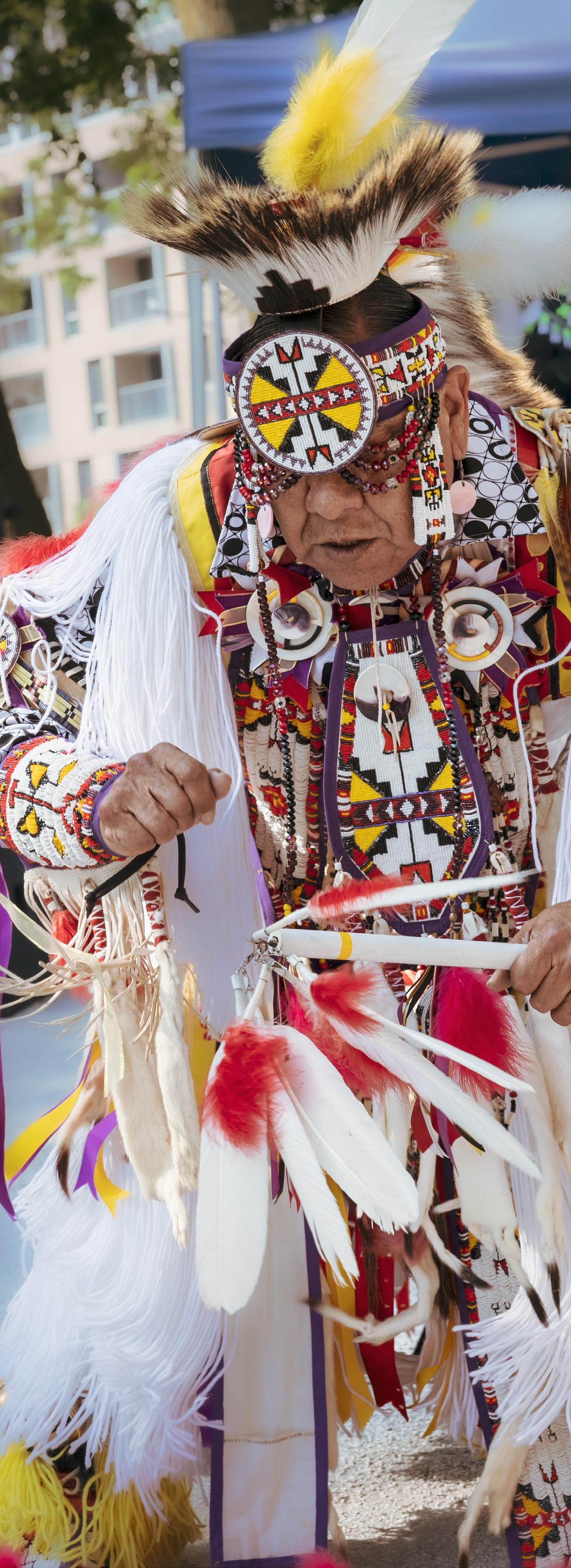

Celebrations across Canada marked National Indigenous Peoples Day June 21, when the sun in the northern hemisphere travels its longest path across the sky. The summer solstice is a time of spiritual renewal and historically a time when Cree families returned from winter and spring camps.
Cree communities recognized the day with cultural activities. The Cree and Inuit of WhapmagoostuiKuujjuaraapik celebrated at First Point (Tikiraq) with a fishing derby, photo hunt, traditional food, fashion contest and log games.
Waskaganish commemorated “the languages reclaimed from silence, and the storytellers, young and old, who carry them forward.” As Robin GullSaganash from Waswanipi said, “We honour those who came before us, and we walk proudly as the ones who carry our culture forward.” And Chisasibi Cree Nation declared, “Let us take pride in who we are and who we are becoming.”
A community feast in Mistissini celebrated 24 young hunters who had harvested their first geese while evening performances included John Henry Shecapio, Patrick Petawabano, Philip Coonishish, Ezekiel Mianscum and Breeze Entertainment (aka Phil Brien). The youth council organized an afternoon barbecue with free refreshments like “rezberry splash”.
“I’m still feeling the energy from that experience,” said Brien, who also hosts workshops for youth involving spray paint art and dance. “The connection, joy and laughter I saw was absolutely touching. I’m filled with pride being Indigenous, celebrating our culture and traditions.”
A special moment for Brien because it was his first show his father attended, he is also excited to soon play his mix of hip hop, country and rock in Montreal for the first time.
“To all the youth out there, do what you love, and the passion will guide you forward,” Brien said. “Never forget where you come from and the resilience of your ancestors. Your voice matters, your story matters, and your future is bright.”
Across the province, Indigenous Peoples Day celebrations are growing larger each year. The Land InSIGHTS ceremony at Montreal’s Old Port began with Mohawk Elder Sedalia Fazio lighting the sacred fire, followed by a tobacco ceremony and drum and dance performances.
“The real importance of this day is that people are finally starting to realize we’re here, we’ve always been here, and we’re not going anywhere,” remarked Fazio. “There’s been a shift among both Indigenous and non-Indigenous people. Young
Indigenous people are happier to be Indigenous than when we were young.”
At Cabot Square, the Native Women’s Shelter of Montreal and POP Montreal hosted a free concert that included Miesha and the Spanks, Digawolf and Leonard Sumner. Elder Ka’nahsohon Kevin Deer opened the event as the popular soapstone carving workshops and Scott Sinquah Family Hoop Dancers returned for another year.
“It’s a beautiful day to be Indigenous,” exclaimed NWSM executive director Nakuset. “From beginning to end, it was perfect. For me, it’s the best day of the year.”
With a stressful job supporting the urban homeless population, she is grateful to POP for accessing grants and bringing in artists from across the country.
“Everything was so easy to put together and flawless,” Nakuset said. “They [POP Montreal] fly people down, put them in hotels and pay for their performance.
Jason Nuaq couldn’t get a flight, so Leonard Sumner came in from Little Saskatchewan in Winnipeg.”
Native Montreal hosted an event in nearby Verdun featuring Backwater Township, throat singers Nina and Sierra Segalowitz, and female drumming group Pow Wow Rangers. The family-friendly gathering included Inuit games, Indigenous artwork, a “kokum cook-off” and seal stew.
“It is really important for [the Inuit] to have a place they can go where people look like them, speak like them, and can help navigate southern environments,” said co-organizer Tina Pisuktie, executive director of the Southern Quebec Inuit Association.
Montreal Mayor Valérie Plante invited members of the Cree Native Arts and Crafts Association and other Indigenous groups to city hall.
“The event with Valérie Plante was very meaningful,” said CNACA executive director Dale Cooper. “I spoke with a lot of Indigenous groups, making connections with people across the city who want to showcase our artists.”
Cooper said there is talk about showcases for Cree artists at the Sanaaq Cultural Centre and the Biodome. He added that the Wachiya Store’s visibility enables CNACA to advocate for Indigenous intellectual property rights.
Seeing mass-produced Indigenous imitations in Montreal stores, Cooper recently called for a Cree-led approach to protect local artists from exploitation at a Cree Nation board council meeting.
“We try to teach the customers about the artists and the message behind the products,” Cooper explained. “We’re trying to push cultural appreciation versus appropriation. When they purchase from Wachiya, they’re directly helping the artists to keep that momentum so teachings can get passed from generation to generation.”

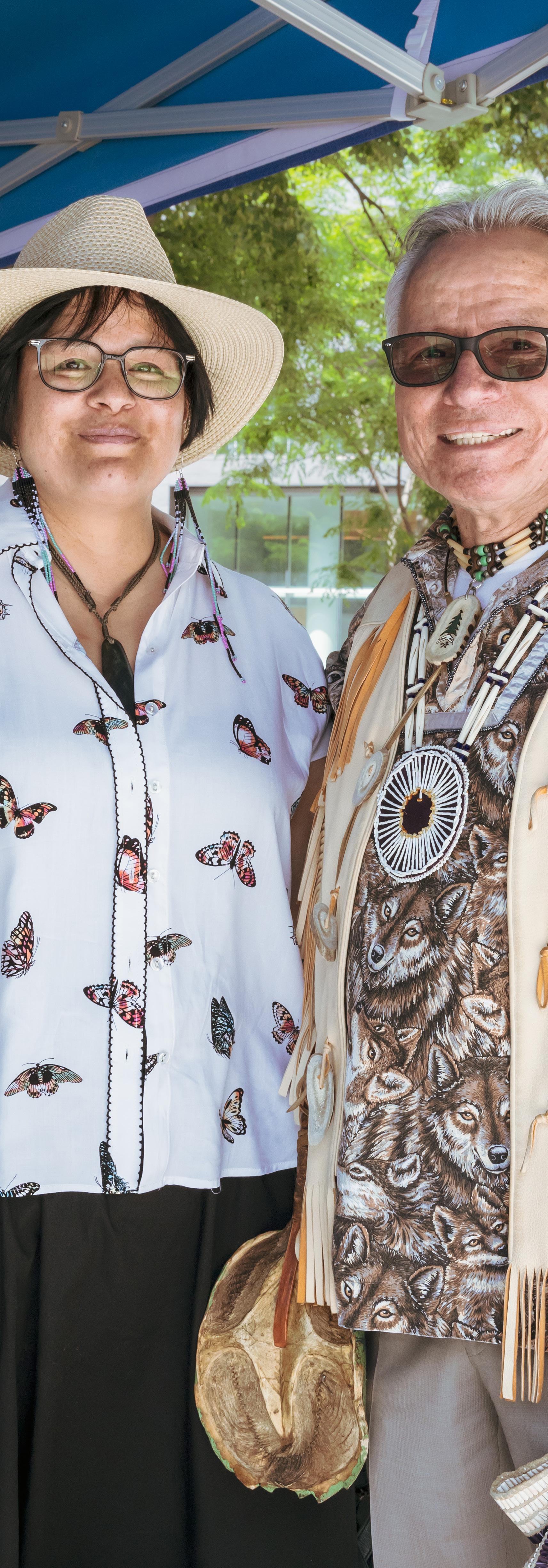




July 3, 2025 — Troilus Gold corp., is proposing the Troilus Mining Project, a new open-pit gold and copper mine located 76 kilometres northwest of the Cree community of Mistissini and approximately 170 kilometres north of Chibougamau, Quebec.
The Joint Assessment Committee (the Joint Committee) comprising of representatives from the Impact Assessment Agency of Canada (IAAC) and the Cree Nation Government invites you to review and provide feedback on the summary of the proponent’s Impact Statement.
Visit the project homepage on the Canadian Impact Assessment Registry (reference number 83658) to:
● Learn more about the project.
● Submit your comments online by 11:59 p.m. on August 17, 2025. All comments will be published to the Registry.
Have questions?

Scan the QR-Code to visit the project homepage.
Write to us at Troilus@iaac-aeic.gc.ca or visit IAAC’s website at canada.ca/iaac.
For media inquiries, contact IAAC's media relations team by writing to media@iaac-aeic.gc.ca.


by Patrick Quinn, Local Journalism
Cree Tourism Association gains an important sustainability certification
The Cree Outfitting and Tourism Association recently earned a Silver Business Certification for sustainable tourism from GreenStep, the largest industry certification program in North America. It’s the first Indigenous destination management organization to attain the honour.
Indigenous Tourism Quebec and the Indigenous Tourism Association of Canada both congratulated COTA on becoming a “true leader in this field.” Since the association’s incorporation 25 years ago, Eeyou Istchee has steadily gained a reputation for cultural depth, world-class fishing and natural beauty.
“GreenStep’s certification process sparked important conversations about how we engage people, serve our communities, and grow our tourism industry in a responsible, values-centred way,” said COTA President Anderson Jolly. “This reaffirmed our commitment to safeguard Cree land, communities and culture for future generations.”
The certification assessment evaluated cultural integrity, environmental impact and community benefits. COTA will undergo a reassessment every
three years to support Indigenous values and environmental stewardship.
“It’s just a first step towards becoming a truly sustainable tourist destination,” said COTA Executive Director Robin McGinley. “Hopefully it will give more visibility to us and to Eeyou Istchee. Now that we understand the global sustainability framework, we’re helping the communities to be more green.”
COTA is helping each community create a tourism plan, such as building campgrounds or gaining accreditation for adventure ecotourism activities. It plans to work with tourism operators like Wiinipaakw Tours to secure certifications for more communities.
“We did a workshop at our AGM tourism conference in Ouje-Bougoumou last year and people were excited to learn more,” McGinley explained. “With hotels, sometimes it’s simple things like LED light bulbs, using soap dispensers instead of little bottles, measuring how much water we use.”
The organization has numerous ideas, such as electric car chargers along Billy Diamond Highway, car-
share and bike-rental programs, and boat-washing stations. It hopes to calculate each community’s carbon footprint to determine steps for improvement.
The Nibiischii wildlife sanctuary will likely be the first entity to pursue GreenStep certification, as it already drafted a sustainability plan through Indigenous Tourism Quebec’s new Shipeku program. The program’s panel of experts guide enterprises through a seven-step journey based on climate change adaptation, pollution reduction and biodiversity regeneration.
Following its first year of operations over the winter, Nibiischii is full throughout the summer at its three sites: Waconichi Lake, Penicouane Bay and Albanel Lake. More availability will open up when a third floating cabin at Waconichi is ready in mid-July. Guests at these Mwakw cabins can now access pontoons to have more space on the water.
Canoes, paddleboards and kayaks are also available for rent. Soon, fat bikes will help visitors travel the 4km to
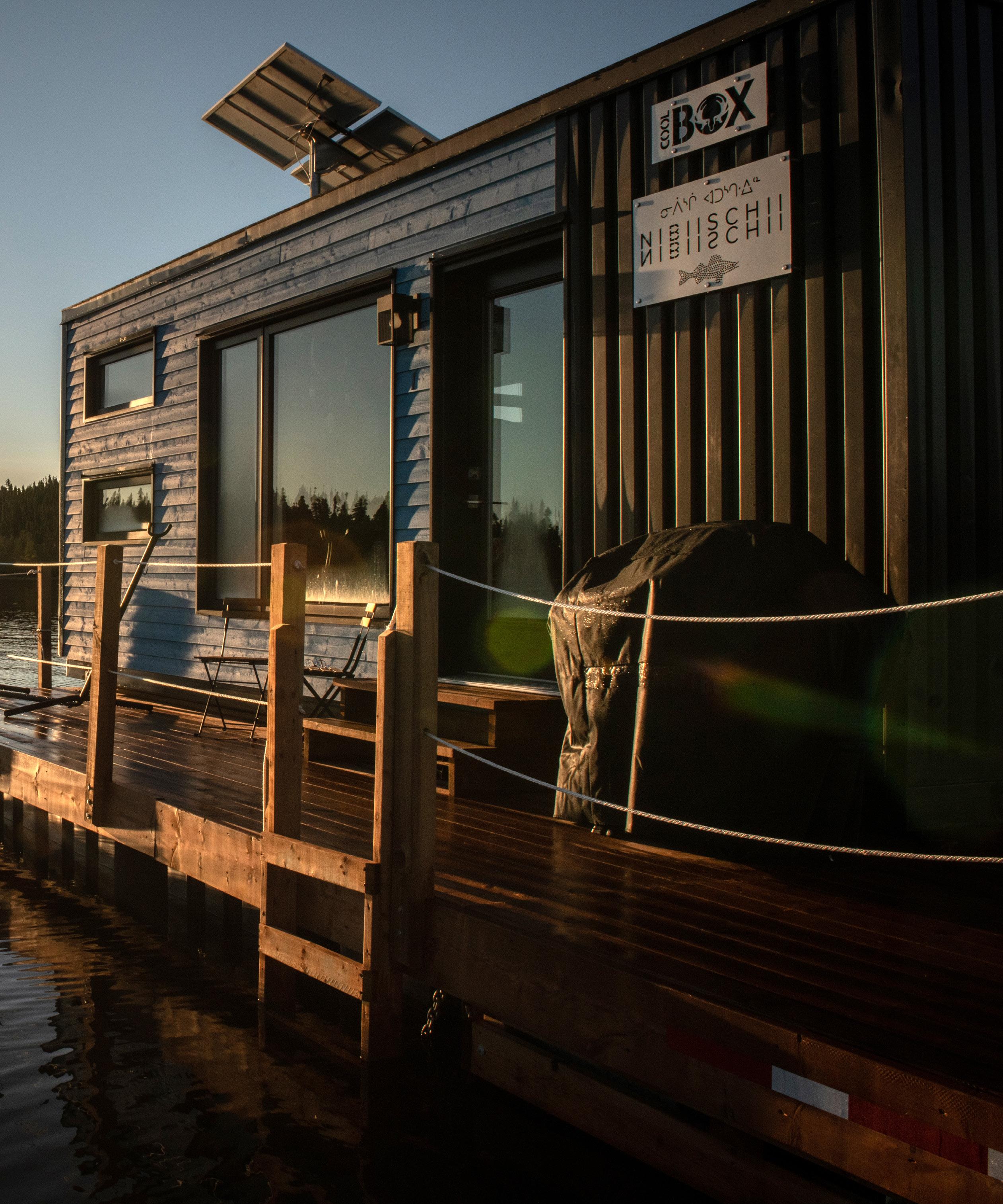
a highly anticipated aerial trail, expected to be completed by October.
The cinema on the water and stargazing observatory are more popular in the autumn because the summer sun sets too late for early-rising fishing clientele. But each site offers monthly cultural activities led by Mario Lord and Francesca Savard-Lévesque. In July, workshops include bannock cooking and goose decoy-making along with quizzes about local wildlife.
“I cook beaver, smoke fish, make bannock or blueberry jam, do some arts and crafts,” explained Lord. “I tell them how we conserved food in the old days when we didn’t have a fridge. Sometimes it’s storytelling, talking about my life in the bush. They’re fascinated to hear how I started from teepees.”
After building a shaptuan traditional dwelling with tarp last summer, Lord plans to make another from wood with two young partners. “I’m starting to make little canoes with bark so they’re going to finish and paint it,” Lord said. “They’re little models or decorations, so the kids will know how canoes were made before fibreglass.”
Youth are a priority. From July 24-26, Nibiischii will be hosting a summer camp from Chibougamau with two groups aged 5 to 11.
COTA’s Niimaawin (“food for travel”) project, first launched at Nibiischii, is refining boil-in-a-bag offerings that are sourced from local ingredients and incorporate traditional Cree cooking techniques. Designed for excursions in the bush or on the water, the meals will be available to outfitters and other Cree entities.
Nibiischii is integrating sustainability initiatives by experimenting with green technologies. During the winter, staff tested electric snowmobiles. Although going fully electric in remote areas is difficult, the team hopes to one day introduce electric ATVs and pickup trucks.
A project planned with the Université de Sherbrooke could greatly reduce Nibiischii’s emissions by reducing waste transported in large trucks. The goal is to employ fish remains and sewage waters as an alternate source of power.
“The goal of this project is to make something small enough that can be transferred to any camp on the land,” said Nibiischii’s director general Mireille Gravel. “Something that’s portable so you can plug it in your sewage system for wet remains. It’s fully part of our mission to pass what we develop to the tallyman or any Indigenous company on the land.”
Nibiischii will soon become a regional base for the Université Laval’s Institut nordique du Québec. This initiative to develop sustainable development technologies adapted to northern realities comes with funding to establish lodging and lab space for scientific researchers.
“We can test the capacity and the limits of every system to see if it’s exportable,” said Gravel. “The research is long and expensive, but we have the sites, the staff and the clients to test it. I think we’re a great lab to do it. Everyone has to do their part in the education of sustainable development.”

Washaw Sibi Chief makes progress on new community near Matagami
by Jamie Pashagumskum
Washaw Sibi was recognized by the Cree Nation in 2003 as the 10th Cree community in Eeyou Istchee.
For decades, Washaw Sibi Eeyou have been working to establish a community for themselves, and Chief Annie Mapachee-Salt remains hopeful the end of that journey might be in sight for the displaced First Nation.
“We have made very significant progress in achieving our ultimate objective: a place to call home,” Mapachee-Salt announced in May.
This came during her presentation to the council board of the Grand Council of the Crees on the progress of establishing the new community. She requested a resolution to engage in a study with the provincial government on the economic benefits of building their new community. The proposed site is south of the Bell River less than 2km from Matagami.
Mapachee-Salt met with Matagami’s mayor and council in June to discuss the proposed location. After presenting her report, the town of Matagami allowed access to the land and asked to be kept informed at every step. Washaw Sibi has hired a firm to conduct ground and water studies, but the Chief said there are still many steps to take with Matagami.
Over the past two decades, the Washaw Sibi Eeyou have studied 12 possible sites. Their most recent vote in 2023 between four locations resulted in 87% of Washaw Sibi members choosing the Matagami site.
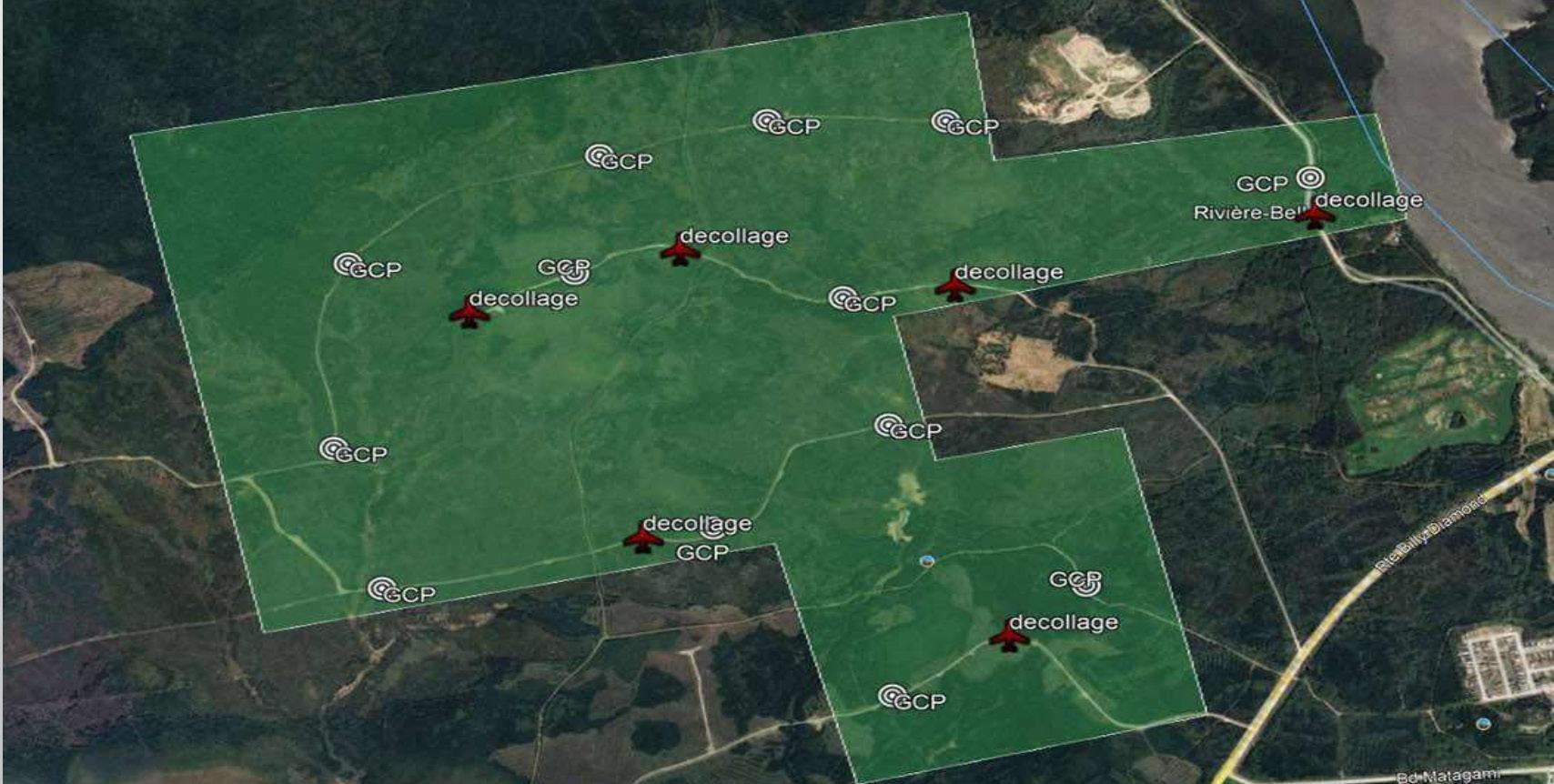
Back in 2014, there was a site chosen off Highway 109 further south, but this location was disputed by Lac Simon and conflicts with neighbouring Algonquin Nations is something Mapachee-Salt said her community wants to avoid.
One of the benefits of building next to Matagami would be the reduced cost. Rather than starting from scratch, as at the proposed Highway 109 site, building next to Matagami could mean sharing existing water and electricity infrastructure.
The Matagami council noted that their current population of 1,400 was once as high as 4,000. The infrastructure was built for a population of 5,000 and could possibly accommodate a community such as Washaw Sibi.
The appearance before the Matagami council helped to dispel some common assumptions MapacheeSalt says exist around their claims for a community. One misconception is that they already come from Cree communities when in fact they are a distinct group.
“Our great-grandmother may have been from Waskaganish, but she raised her family on the land north of La Sarre, east of Cochrane, south of Waskaganish and around Matagami,” Mapachee-Salt stated.
“We are not from Waskaganish. We are not from Waswanipi, but we had to be affiliated with them in order to receive our beneficiary numbers,” she insisted. “I’ve never lived in Waskaganish and my Mom never lived in Waskaganish. I think people are beginning to understand who Washaw Sibi is.”
Mapachee-Salt told the Matagami council how in the 1940s there were 14 Cree families living in the La Sarre area. She even presented photographs and documents dating back over 100 years showing Crees living in the southernmost regions of Eeyou Istchee.
“We are a people who were always there. La Sarre was the area where Crees would spend their summers.”
Indian Affairs would eventually force the Washaw Sibi Eeyou to relocate to places like Pikogan and Moose Factory.
Washaw Sibi’s struggle is similar to that of Ouje-Bougoumou. Built in 1992, it is so far the only Cree community established after the JBNQA was signed in 1975.
For that reason, former Grand Chief Abel Bosum, who was instrumental in establishing Ouje, was brought in as an advisor to help facilitate the complex process between Washaw Sibi and the governments of Canada and Quebec.
Bosum said there are parts of the Ouje-Bougoumou process that could be applied to Washaw Sibi’s cause. He comes to the table with both lessons learned and a focused approach.
“I know them. I know where they’re coming from,” Bosum told the Nation “The main challenges are political – in the Cree world, in the region and with governments.”
Once a suitable location is agreed upon by all parties, the next step will be to designate category 1A land for the Washaw Sibi community.
Unfortunately for Washaw Sibi, the Quebec government is not willing to increase the Cree Nation land quota
that was negotiated in 1975. Therefore, similar to OujeBougoumou’s creation, pockets of land will have to be re-assigned from other Cree communities to Washaw Sibi.
While adding lands to the JBNQA is not possible, an exchange of land is. Legally, the land is owned by Quebec and the establishment of a federally recognized community requires passing title of that land to the federal government.
“Each community has its land set aside. So, when Whapmagoostui agrees to grant one square kilometre; instead of having 800 square kilometres they will have 799 and that one kilometre will be given to Quebec,” Bosum explained.
So far, Bosum said five Cree First Nations have offed to donate one square kilometre of category 1A land to Washaw Sibi.
The new Cree town is hoping for nine kilometres, but five is considered sufficient to build. Bosum said politically, support from Cree communities opens up further opportunities when negotiating with Quebec.
Bosum says the keys to success are political influence and economic incentives.
Essential to Quebec’s acceptance is the newly mandated economic impact study which could give Washaw Sibi the extra leverage they need in gaining support from not only the Baie-James and Abitibi regions, but also from the province.
“Matagami is a town that is dying. There is no economic activity, and the population is going down,” Bosum said.
“Having a community nearby would stimulate the economy much the way Ouje did for Chapais and Chibougamau. The Cree today have big economic impacts. They generate a lot of economic activity around these municipalities. If the report can prove that, then there will be benefits.”
Once Quebec is on board, Bosum said the final piece is recognition from the federal government and an amendment to the JBNQA. Washaw Sibi is currently opening an office in Matagami with a liaison officer and an information centre.
Bosum remembers the overwhelming feelings of joy Ouje-Bougoumou families felt moving into their new community.
“It’s hard to explain. You have to go through that process to understand. It’s the greatest feeling, the feeling that I’m going back to my homeland,” Bosum said. “The second greatest is once the community is built, and you actually enter into your own home.”
One hopes that feeling will arrive sooner than later for Washaw Sibi. Chief Mapachee-Salt is mourning the recent passing of her aunt, the last sibling of eight.
“Seeing that whole family gone is discouraging,” she said. “They were the ones who really had that hope, that dream to make it happen for future generations. It’s taken a long time, but hopefully my generation will see our children and grandchildren in that community.”
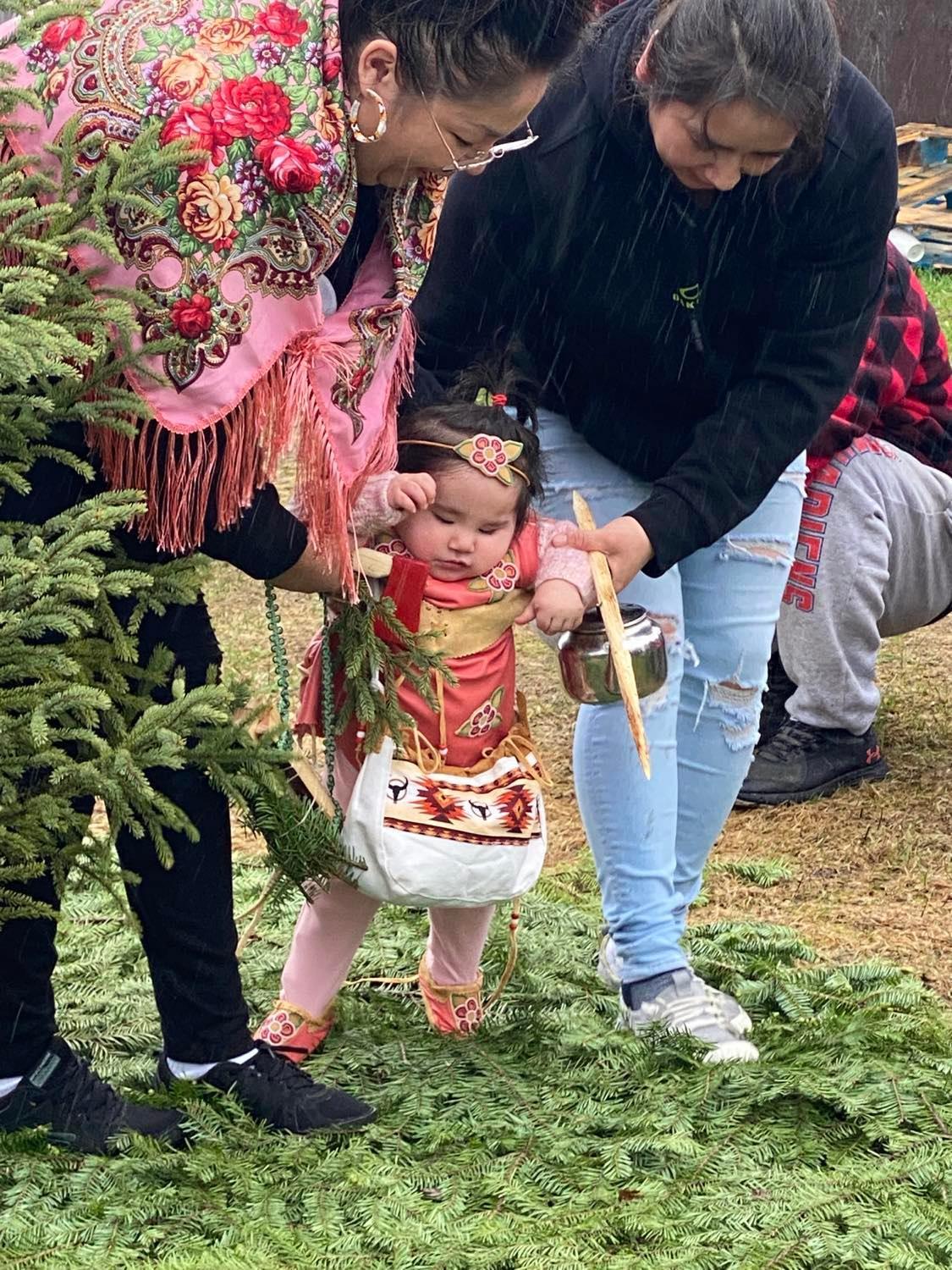
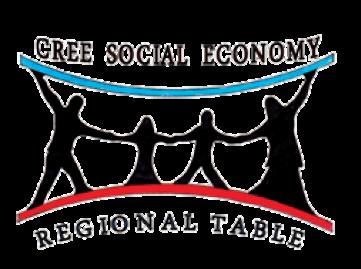




Crossword by Margie E. Burke
Here’s another edition of the Nation’s puzzle page. Try your hand at Sudoku or Str8ts or our Crossword, or better yet, solve all three and send us a photo!* As always, the answers from last issue are here for you to check your work. Happy hunting.
PREVIOUS SOLUTION: Solution to Crossword:






by Xavier Kataquapit
First Nation youth are rising up to protest Canada’s Bill C-5 and Ontario’s Bill 5 because both threaten pristine wilderness in Northern Ontario. These two bills bypass the idea of Free, Prior and Informed Consent (FPIC) which is a principle within the UN Declaration on the Rights of Indigenous Peoples (UNDRIP) that emphasizes the right of Indigenous peoples to give or withhold their consent to activities that affect their lands, territories and resources.
Both the federal and provincial governments used the excuse of US tariff threats to push through these bills. It should be noted that both governments also used this excuse in their bid to win recent elections, and this worked for them. Arrogantly they have refused to include First Nations before setting up and pushing through these historic bills.
The Assembly of First Nations Chiefs raised strong concerns over Bill C-5’s rushed legislative process, lack of consultation, and narrowly defined national interest that excludes First Nations priorities and perspectives.”
Bill 5, the Protect Ontario by Unleashing Our Economy Act, allows Ontario to create special economic zones, where companies or projects can be exempted from having to comply with provincial laws, regulations or municipal bylaws.
Protests are developing in Ontario through First Nation leadership including AFN, Chiefs of Ontario, Nishnawbe-Aski Nation, Mushkegowuk Council, many of the Chiefs and Councils, Elders and members supporting the youth-driven initiatives. There are major youth groups organizing these protests including Youth Rising Together in Timmins and Okiniwak, a national group formed by First Nation youth in Ontario.
On the land in the remote traditional lands of the Cree and Oji-Cree are youth leader Jeronimo Kataquapit, his brother Jonathan and their parents James and Monique. The family braved the challenging freighter canoe trip of 400 km from Attawapiskat to Neskantaga to join up with other First Nations protesting Bill C-5 and Bill 5 in protecting their treaty rights and their traditional lands. You can follow Jeronimo and his family who provide daily live stream updates through their Facebook group, Here We Stand: Call to Action.
These youth are appealing to other First Nation youth, Chiefs, councillors and Elders to become involved in developing protests in their areas and communities to support them and to push back on these undemocratic bills. This is an important time for all of us to stand up for the land to make sure our future generations will have a life, safe water, clean air and an environment that is still healthy for people.
I have witnessed over the years that it is possible to create mutually beneficial agreements with industry, government and First Nations. A few decades ago, this was not the case and historically we were ignored as resource development companies made billions in our backyards.
I am all for working together to make good projects happen that benefit our people, but this particular focus on the Ring of Fire area and Hudson Bay lowlands is extremely worrying for First Nations as well as all Canadians and people across the planet.
This pristine wilderness contains the second largest carbon sink in the world and is even bigger than the Amazon Basin that we hear so much about. This natural wilderness plays a crucial role in mitigating climate change by reducing atmo-

spheric carbon. We need these carbon sinks to fight climate change. The Society of Wetland Scientists provides a detailed explanation of this in their video webinar, Peatlands in Canada with a Focus on the Hudson Bay Lowland.
Right now, we are seeing temperatures rise all over the world. We see huge storms, flooding, polar ice caps melting, and huge forest fires as a result of climate change. This is not the time to make things worse by destroying such a huge and important carbon sink right here in northern Ontario.
The problem is that government is focusing primarily on prioritizing profits, business and corporations at the expense of destroying important natural habitats and contributing to the endangerment of life not just for Canada but for the entire world. The buck has to stop somewhere, and this is that point.
We can all find ways to protest. Recently, my brother Joseph, his wife Lynda, their sons Orion and Landyn and my sister Janie and her husband Brian went to London, England with the Attawapiskat flag which they proudly raised at the gates of Buckingham Palace in protest of Bill C-5 and Bill 5. Their trip was also to visit the grave of our great-grandfather John Chookomolin, a First World War veteran, who is buried just outside London. You can read about his story on my website at www.nativeveterans.com
My family wanted to remind everyone of the sacrifice our people had to make for this country and how our families continue to fight to protect the land we call home, not just for the people of James Bay but for all of Canada.


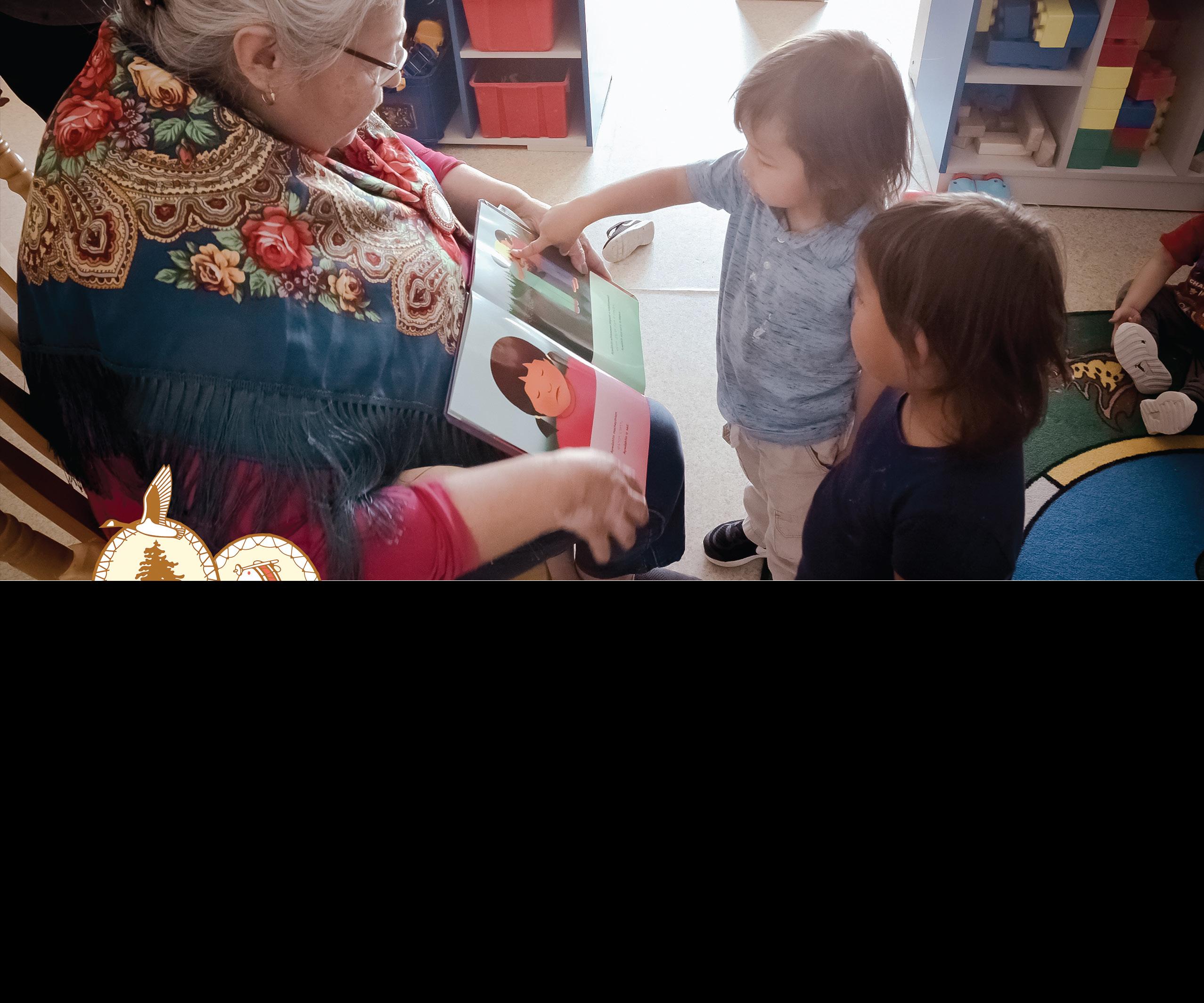






















The Cree IELCC Fund is designed to fund projects/activities that foster the education, Cree culture and language, as well as health and wellbeing of children 0 to 6 and their families.
All projects and activities must also ensure that no children are left behind: activities must be accessible to all children, no matter their level of ability or special need.












































